Financial and Monetary Theory: Exogenous vs. Endogenous Money Supply
VerifiedAdded on 2021/05/27
|8
|2021
|24
Report
AI Summary
This report delves into the core concepts of financial and monetary theory, specifically focusing on the contrasting theories of money creation: exogenous and endogenous money supply. The analysis begins with an introduction and literature review, exploring the historical development of these ideas. The report then dissects the mechanisms of money creation under both models, highlighting the critical role and varying impact of central banks in each. For exogenous money, the report examines how central banks control the money supply, while for endogenous money, it explains how money creation is driven by economic variables. A key aspect of the report is the comparison of monetary policy changes under both paradigms. The report concludes by summarizing the key differences between exogenous and endogenous money creation, and the implications for monetary policy. The references provide a comprehensive list of sources used in the analysis.
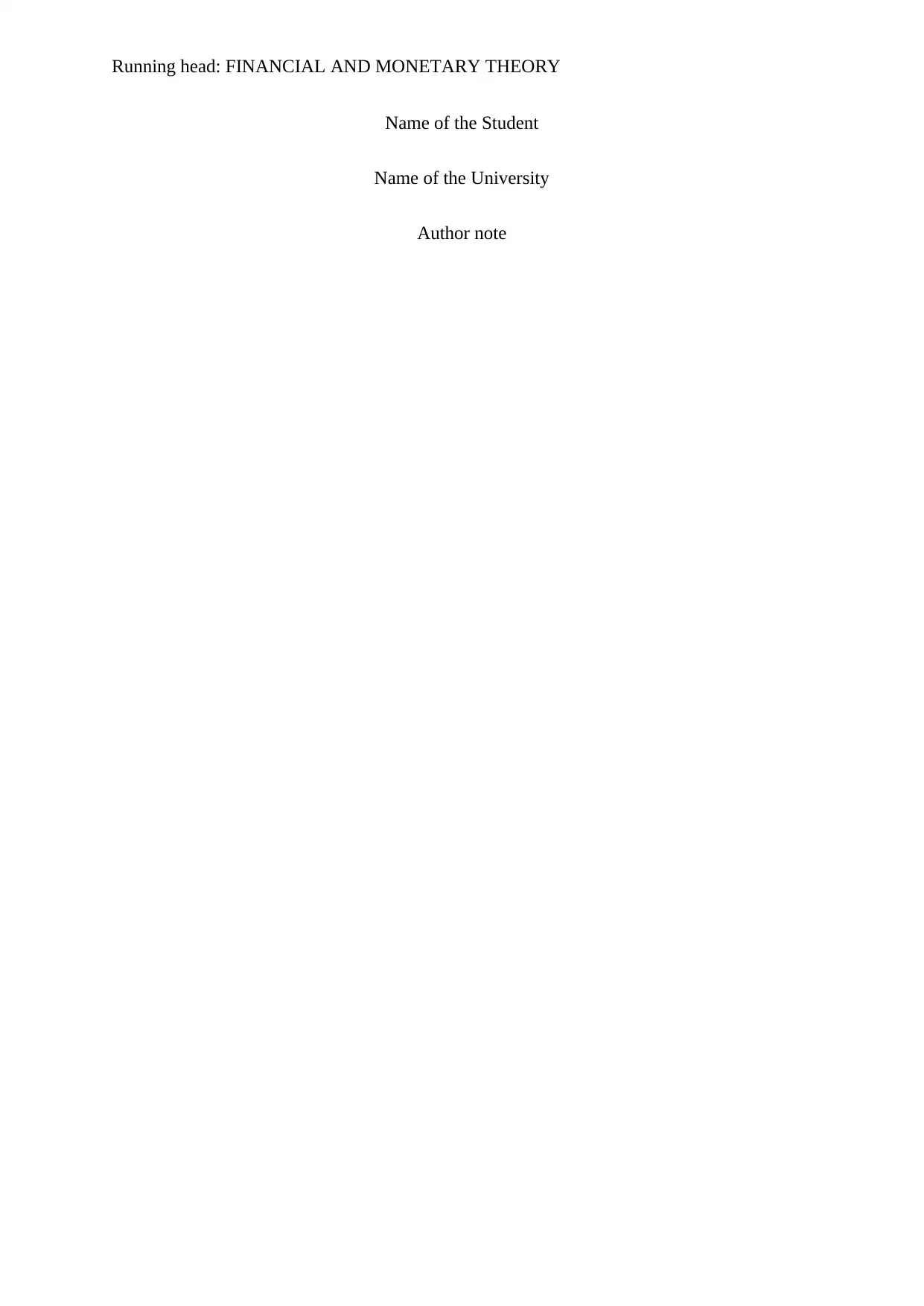
Running head: FINANCIAL AND MONETARY THEORY
Name of the Student
Name of the University
Author note
Name of the Student
Name of the University
Author note
Paraphrase This Document
Need a fresh take? Get an instant paraphrase of this document with our AI Paraphraser
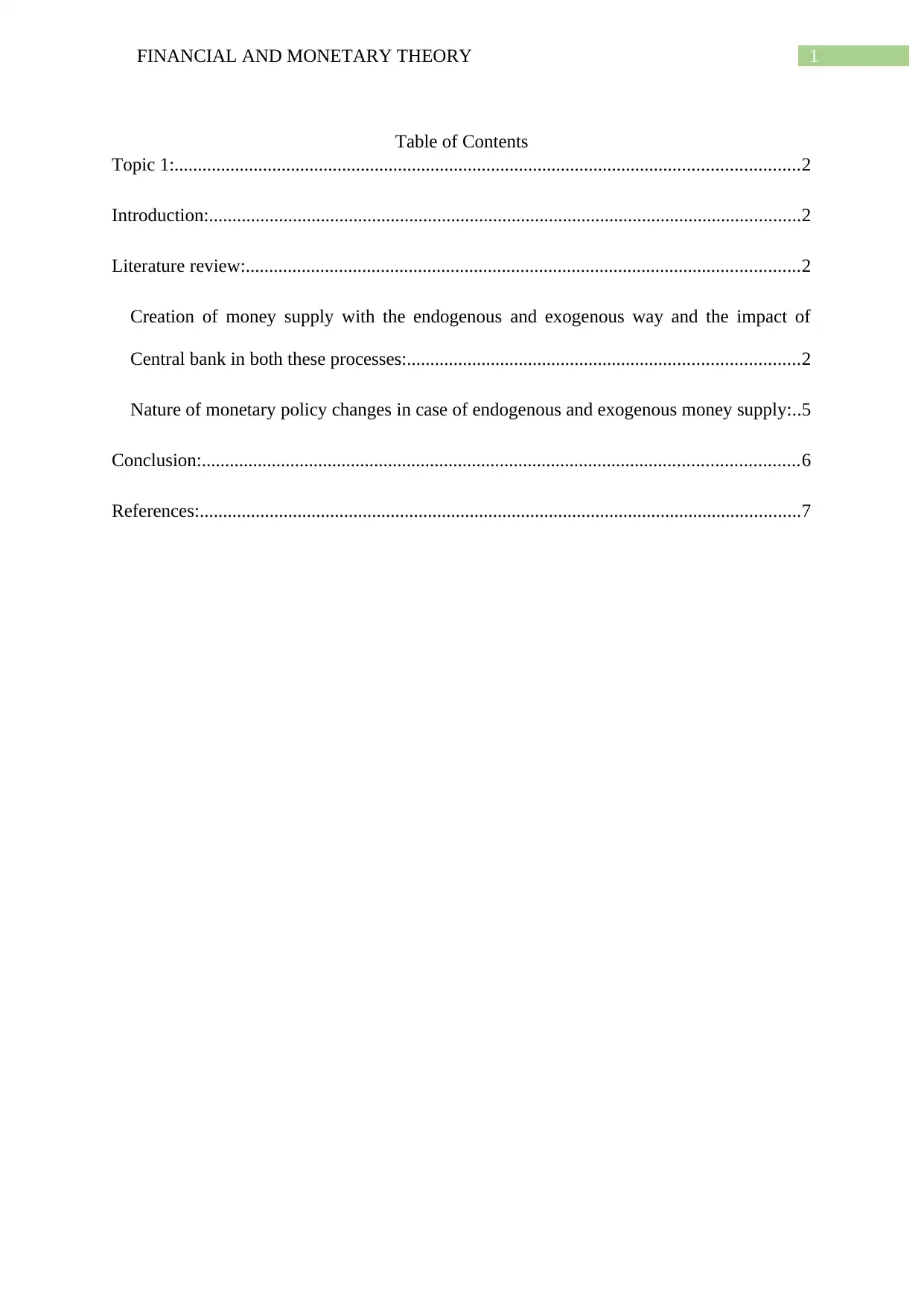
1FINANCIAL AND MONETARY THEORY
Table of Contents
Topic 1:......................................................................................................................................2
Introduction:...............................................................................................................................2
Literature review:.......................................................................................................................2
Creation of money supply with the endogenous and exogenous way and the impact of
Central bank in both these processes:....................................................................................2
Nature of monetary policy changes in case of endogenous and exogenous money supply:..5
Conclusion:................................................................................................................................6
References:.................................................................................................................................7
Table of Contents
Topic 1:......................................................................................................................................2
Introduction:...............................................................................................................................2
Literature review:.......................................................................................................................2
Creation of money supply with the endogenous and exogenous way and the impact of
Central bank in both these processes:....................................................................................2
Nature of monetary policy changes in case of endogenous and exogenous money supply:..5
Conclusion:................................................................................................................................6
References:.................................................................................................................................7
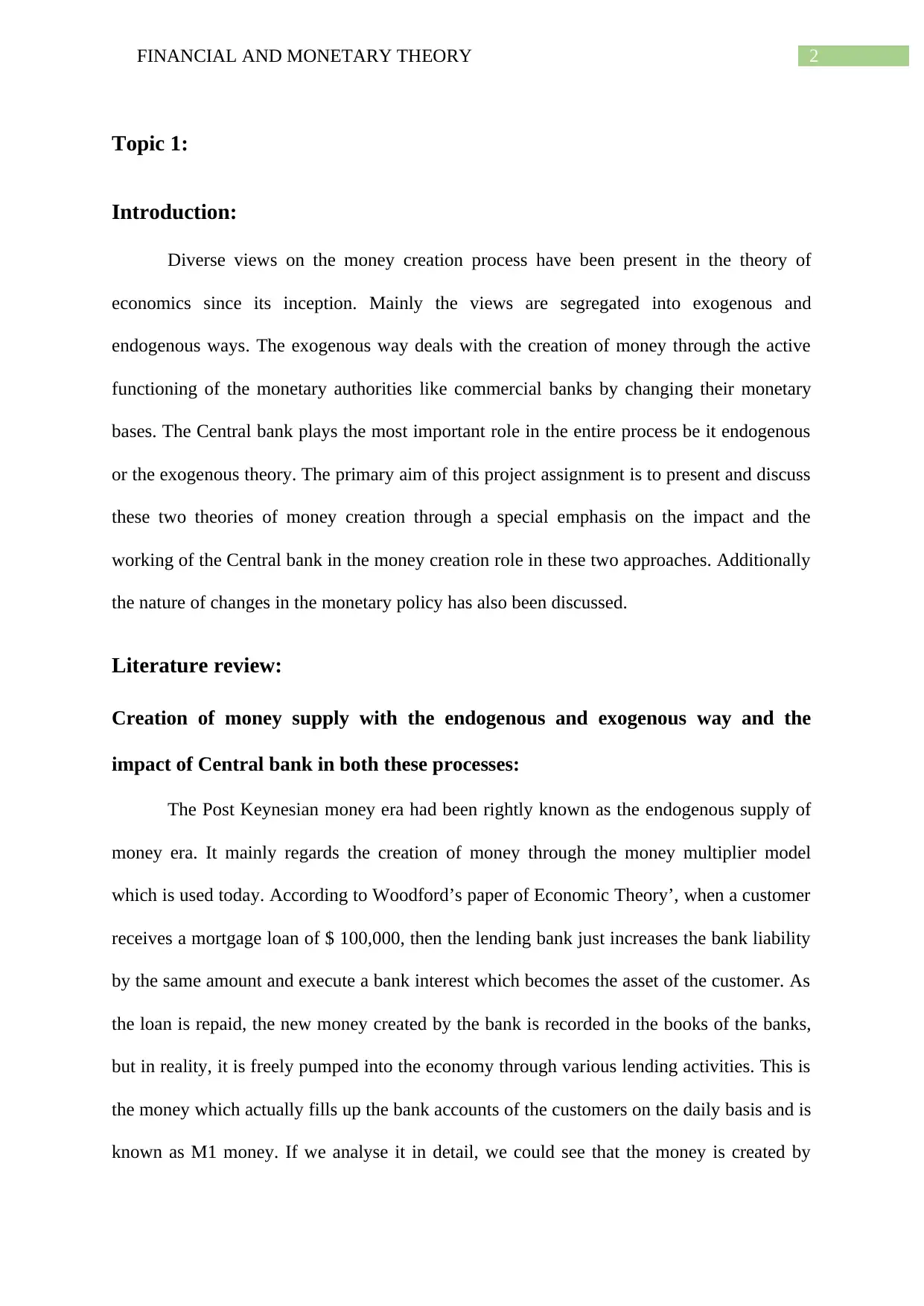
2FINANCIAL AND MONETARY THEORY
Topic 1:
Introduction:
Diverse views on the money creation process have been present in the theory of
economics since its inception. Mainly the views are segregated into exogenous and
endogenous ways. The exogenous way deals with the creation of money through the active
functioning of the monetary authorities like commercial banks by changing their monetary
bases. The Central bank plays the most important role in the entire process be it endogenous
or the exogenous theory. The primary aim of this project assignment is to present and discuss
these two theories of money creation through a special emphasis on the impact and the
working of the Central bank in the money creation role in these two approaches. Additionally
the nature of changes in the monetary policy has also been discussed.
Literature review:
Creation of money supply with the endogenous and exogenous way and the
impact of Central bank in both these processes:
The Post Keynesian money era had been rightly known as the endogenous supply of
money era. It mainly regards the creation of money through the money multiplier model
which is used today. According to Woodford’s paper of Economic Theory’, when a customer
receives a mortgage loan of $ 100,000, then the lending bank just increases the bank liability
by the same amount and execute a bank interest which becomes the asset of the customer. As
the loan is repaid, the new money created by the bank is recorded in the books of the banks,
but in reality, it is freely pumped into the economy through various lending activities. This is
the money which actually fills up the bank accounts of the customers on the daily basis and is
known as M1 money. If we analyse it in detail, we could see that the money is created by
Topic 1:
Introduction:
Diverse views on the money creation process have been present in the theory of
economics since its inception. Mainly the views are segregated into exogenous and
endogenous ways. The exogenous way deals with the creation of money through the active
functioning of the monetary authorities like commercial banks by changing their monetary
bases. The Central bank plays the most important role in the entire process be it endogenous
or the exogenous theory. The primary aim of this project assignment is to present and discuss
these two theories of money creation through a special emphasis on the impact and the
working of the Central bank in the money creation role in these two approaches. Additionally
the nature of changes in the monetary policy has also been discussed.
Literature review:
Creation of money supply with the endogenous and exogenous way and the
impact of Central bank in both these processes:
The Post Keynesian money era had been rightly known as the endogenous supply of
money era. It mainly regards the creation of money through the money multiplier model
which is used today. According to Woodford’s paper of Economic Theory’, when a customer
receives a mortgage loan of $ 100,000, then the lending bank just increases the bank liability
by the same amount and execute a bank interest which becomes the asset of the customer. As
the loan is repaid, the new money created by the bank is recorded in the books of the banks,
but in reality, it is freely pumped into the economy through various lending activities. This is
the money which actually fills up the bank accounts of the customers on the daily basis and is
known as M1 money. If we analyse it in detail, we could see that the money is created by
⊘ This is a preview!⊘
Do you want full access?
Subscribe today to unlock all pages.

Trusted by 1+ million students worldwide
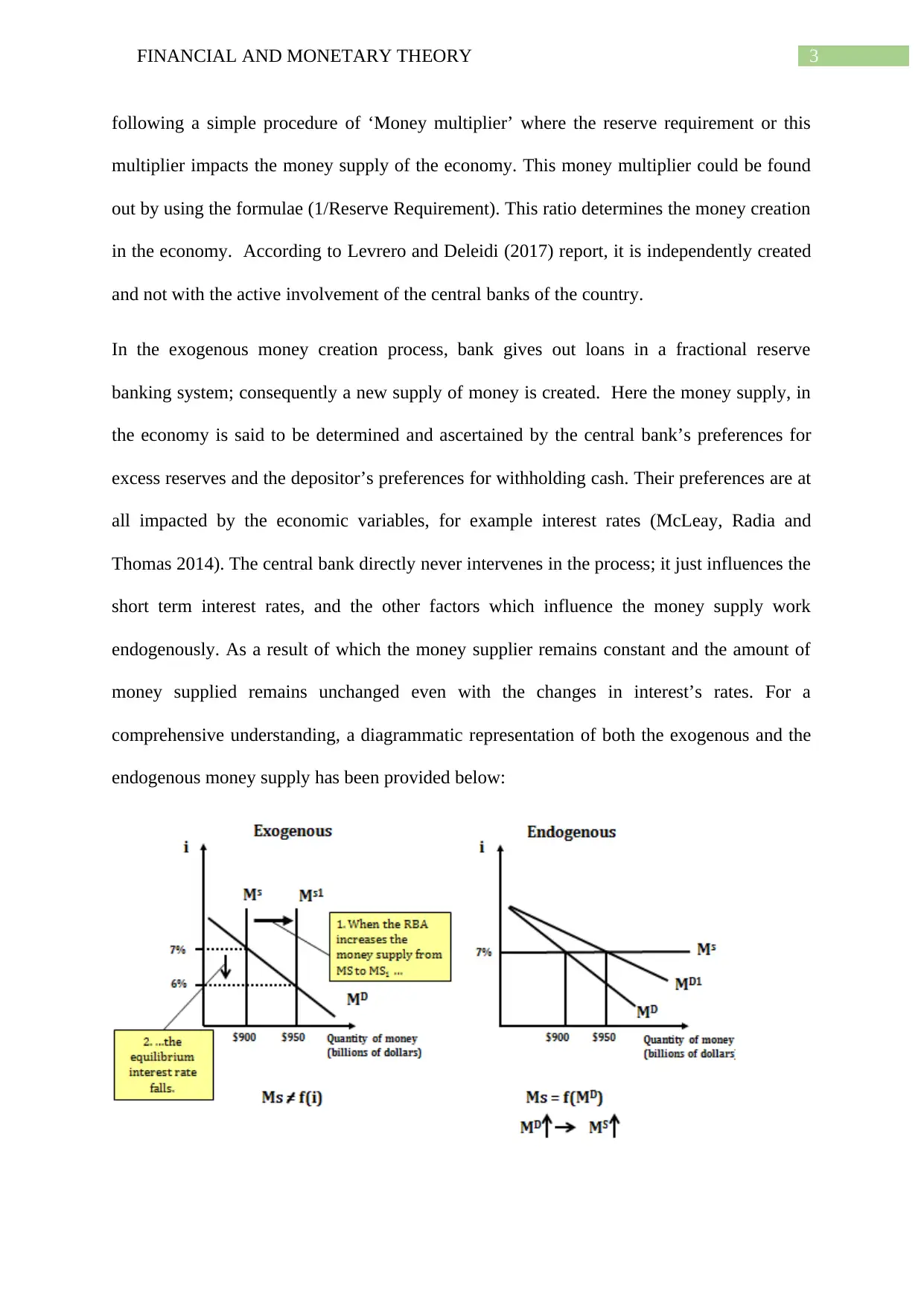
3FINANCIAL AND MONETARY THEORY
following a simple procedure of ‘Money multiplier’ where the reserve requirement or this
multiplier impacts the money supply of the economy. This money multiplier could be found
out by using the formulae (1/Reserve Requirement). This ratio determines the money creation
in the economy. According to Levrero and Deleidi (2017) report, it is independently created
and not with the active involvement of the central banks of the country.
In the exogenous money creation process, bank gives out loans in a fractional reserve
banking system; consequently a new supply of money is created. Here the money supply, in
the economy is said to be determined and ascertained by the central bank’s preferences for
excess reserves and the depositor’s preferences for withholding cash. Their preferences are at
all impacted by the economic variables, for example interest rates (McLeay, Radia and
Thomas 2014). The central bank directly never intervenes in the process; it just influences the
short term interest rates, and the other factors which influence the money supply work
endogenously. As a result of which the money supplier remains constant and the amount of
money supplied remains unchanged even with the changes in interest’s rates. For a
comprehensive understanding, a diagrammatic representation of both the exogenous and the
endogenous money supply has been provided below:
following a simple procedure of ‘Money multiplier’ where the reserve requirement or this
multiplier impacts the money supply of the economy. This money multiplier could be found
out by using the formulae (1/Reserve Requirement). This ratio determines the money creation
in the economy. According to Levrero and Deleidi (2017) report, it is independently created
and not with the active involvement of the central banks of the country.
In the exogenous money creation process, bank gives out loans in a fractional reserve
banking system; consequently a new supply of money is created. Here the money supply, in
the economy is said to be determined and ascertained by the central bank’s preferences for
excess reserves and the depositor’s preferences for withholding cash. Their preferences are at
all impacted by the economic variables, for example interest rates (McLeay, Radia and
Thomas 2014). The central bank directly never intervenes in the process; it just influences the
short term interest rates, and the other factors which influence the money supply work
endogenously. As a result of which the money supplier remains constant and the amount of
money supplied remains unchanged even with the changes in interest’s rates. For a
comprehensive understanding, a diagrammatic representation of both the exogenous and the
endogenous money supply has been provided below:
Paraphrase This Document
Need a fresh take? Get an instant paraphrase of this document with our AI Paraphraser
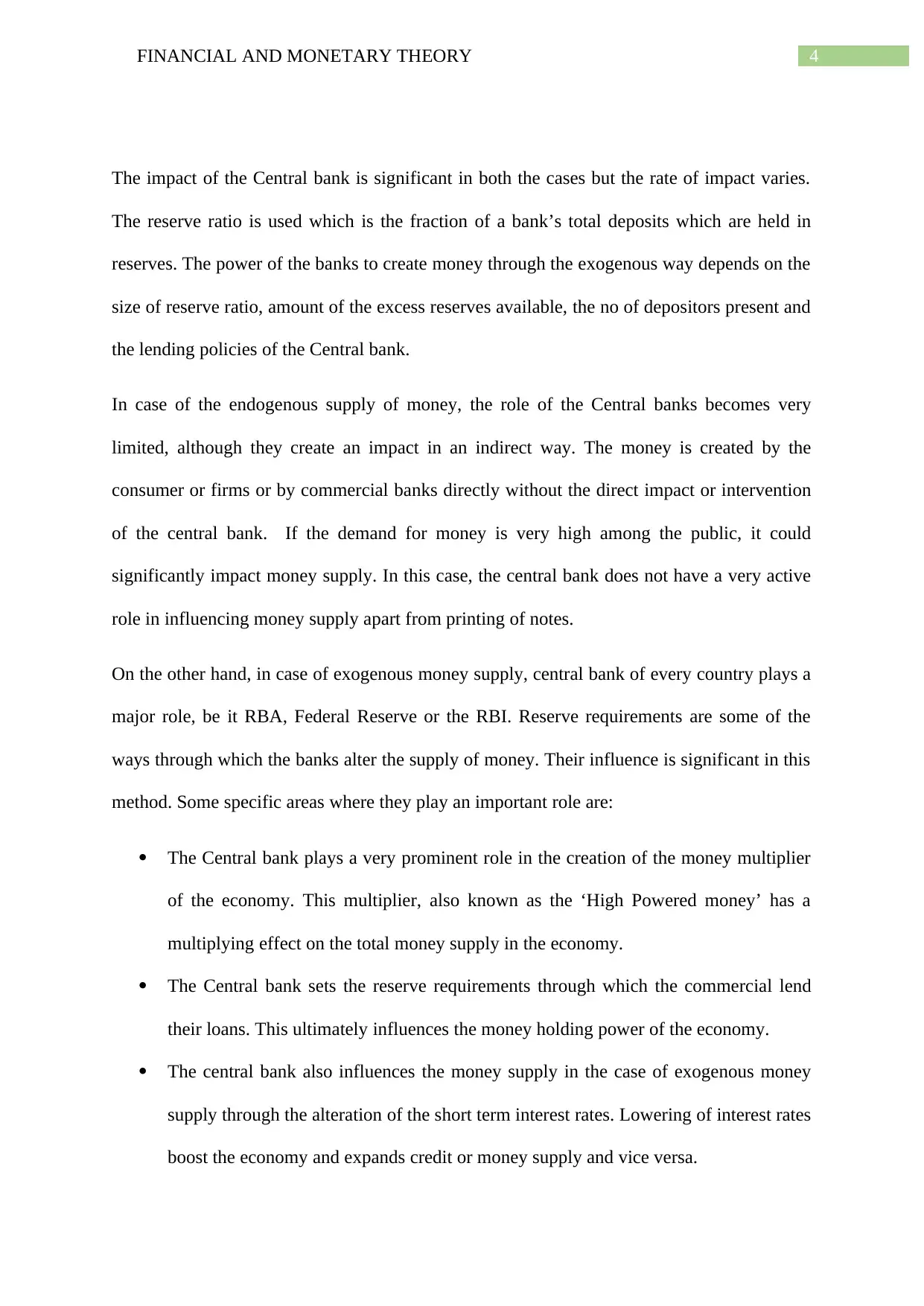
4FINANCIAL AND MONETARY THEORY
The impact of the Central bank is significant in both the cases but the rate of impact varies.
The reserve ratio is used which is the fraction of a bank’s total deposits which are held in
reserves. The power of the banks to create money through the exogenous way depends on the
size of reserve ratio, amount of the excess reserves available, the no of depositors present and
the lending policies of the Central bank.
In case of the endogenous supply of money, the role of the Central banks becomes very
limited, although they create an impact in an indirect way. The money is created by the
consumer or firms or by commercial banks directly without the direct impact or intervention
of the central bank. If the demand for money is very high among the public, it could
significantly impact money supply. In this case, the central bank does not have a very active
role in influencing money supply apart from printing of notes.
On the other hand, in case of exogenous money supply, central bank of every country plays a
major role, be it RBA, Federal Reserve or the RBI. Reserve requirements are some of the
ways through which the banks alter the supply of money. Their influence is significant in this
method. Some specific areas where they play an important role are:
The Central bank plays a very prominent role in the creation of the money multiplier
of the economy. This multiplier, also known as the ‘High Powered money’ has a
multiplying effect on the total money supply in the economy.
The Central bank sets the reserve requirements through which the commercial lend
their loans. This ultimately influences the money holding power of the economy.
The central bank also influences the money supply in the case of exogenous money
supply through the alteration of the short term interest rates. Lowering of interest rates
boost the economy and expands credit or money supply and vice versa.
The impact of the Central bank is significant in both the cases but the rate of impact varies.
The reserve ratio is used which is the fraction of a bank’s total deposits which are held in
reserves. The power of the banks to create money through the exogenous way depends on the
size of reserve ratio, amount of the excess reserves available, the no of depositors present and
the lending policies of the Central bank.
In case of the endogenous supply of money, the role of the Central banks becomes very
limited, although they create an impact in an indirect way. The money is created by the
consumer or firms or by commercial banks directly without the direct impact or intervention
of the central bank. If the demand for money is very high among the public, it could
significantly impact money supply. In this case, the central bank does not have a very active
role in influencing money supply apart from printing of notes.
On the other hand, in case of exogenous money supply, central bank of every country plays a
major role, be it RBA, Federal Reserve or the RBI. Reserve requirements are some of the
ways through which the banks alter the supply of money. Their influence is significant in this
method. Some specific areas where they play an important role are:
The Central bank plays a very prominent role in the creation of the money multiplier
of the economy. This multiplier, also known as the ‘High Powered money’ has a
multiplying effect on the total money supply in the economy.
The Central bank sets the reserve requirements through which the commercial lend
their loans. This ultimately influences the money holding power of the economy.
The central bank also influences the money supply in the case of exogenous money
supply through the alteration of the short term interest rates. Lowering of interest rates
boost the economy and expands credit or money supply and vice versa.

5FINANCIAL AND MONETARY THEORY
Thus, the impact of the central bank of the country is significantly higher in the case of
exogenous money supply.
Nature of monetary policy changes in case of endogenous and exogenous money
supply:
Monetary policy is one of the most important public policy of the Central banks of
various countries. It is created with the sole intention of checking the unwanted growth of
inflation in the economy. This helps in preserving the actual value of money and also
encourages strong and sustainable growth of the economy for a long period of time.
Monetary policy is one of the most important functions of the Central bank of any country
(Goodfriend, 2011). It is typically carried out and implemented for the purpose of checking
the inflation rate of the economy. Some of the important tools used by the central bank in this
regard are credit control mechanism and moral suasion, just to name a few. The main form of
monetary policy is expansionary and contractionary. Both are used by the central bank as is
necessary, which depends on the needs of the economy.
In the case of exogenous policy, the central bank of the country determines the reserve
requirements of the economy. In this process, the central bank decides the cash rate of the
commercial banks of the economy. Due to this increase in the cash rate, the commercial
banks increase their lending rate, as a result of which, money supply is contracted. In this
way, a slight change in the cash rate of the banks could influence the term structures of the
interest rates in the entire economy. In the case of endogenous money supply, the central
bank of the country influences the money supply in various ways, but not directly. It depends
on the functioning of various external economic variables such as national income, national
investment and national savings (Dow, 2006). In this case, the central bank’s monetary policy
is executed through revision of discount rates, open market operations and various other
outlets. The changes in these rates lead to a significant amount of impact upon the business
Thus, the impact of the central bank of the country is significantly higher in the case of
exogenous money supply.
Nature of monetary policy changes in case of endogenous and exogenous money
supply:
Monetary policy is one of the most important public policy of the Central banks of
various countries. It is created with the sole intention of checking the unwanted growth of
inflation in the economy. This helps in preserving the actual value of money and also
encourages strong and sustainable growth of the economy for a long period of time.
Monetary policy is one of the most important functions of the Central bank of any country
(Goodfriend, 2011). It is typically carried out and implemented for the purpose of checking
the inflation rate of the economy. Some of the important tools used by the central bank in this
regard are credit control mechanism and moral suasion, just to name a few. The main form of
monetary policy is expansionary and contractionary. Both are used by the central bank as is
necessary, which depends on the needs of the economy.
In the case of exogenous policy, the central bank of the country determines the reserve
requirements of the economy. In this process, the central bank decides the cash rate of the
commercial banks of the economy. Due to this increase in the cash rate, the commercial
banks increase their lending rate, as a result of which, money supply is contracted. In this
way, a slight change in the cash rate of the banks could influence the term structures of the
interest rates in the entire economy. In the case of endogenous money supply, the central
bank of the country influences the money supply in various ways, but not directly. It depends
on the functioning of various external economic variables such as national income, national
investment and national savings (Dow, 2006). In this case, the central bank’s monetary policy
is executed through revision of discount rates, open market operations and various other
outlets. The changes in these rates lead to a significant amount of impact upon the business
⊘ This is a preview!⊘
Do you want full access?
Subscribe today to unlock all pages.

Trusted by 1+ million students worldwide

6FINANCIAL AND MONETARY THEORY
investment, consumer spending and the net exports of the country. These are the main
expenditure channels of the economy, through which the monetary policy of the central banks
impacts their performance. These areas are primarily affected by the contactionary and as
well as the expansionary monetary policy of the economy (Sunderam. 2014). This has a
direct impact on the economic growth rate of the economy. Thus it can be said that the nature
of the monetary policy remains the same in both the exogenous as well as the endogenous
money creation procedures. The nature of the monetary policy of the economy and the way of
executing of the policy in case of these money creating mechanisms remains constant. This is
because the objective of the government remains the same, which is to keep a check on the
inflation problems of the economy and keeping the unemployment problem in control.
Conclusion:
Money creation is one of the most important functions of the central bank of any
economy. As money is the basis for the financial and commercial existence of any economy,
this function of the central bank cannot be ignored at all. In this report a comprehensive
analysis and understanding of both the exogenous as well as the endogenous ways of creation
of money has been discussed. Exogenous money creation is directly made by the direct
interference of the central bank of any country, whereas , the endogenous creation of money
is made by the independent economic variables and is not directly influenced by then central
bank of the country. The impact and role of the central banks in both these processes of
money creation has been discussed in this report too. Along with these, the nature of changes
in the monetary policy of the economy, because of the implementation of both these money
creation mechanisms have also been understood and discussed. This report has been
successful in unearthing the intricacies of money supply in any economy.
investment, consumer spending and the net exports of the country. These are the main
expenditure channels of the economy, through which the monetary policy of the central banks
impacts their performance. These areas are primarily affected by the contactionary and as
well as the expansionary monetary policy of the economy (Sunderam. 2014). This has a
direct impact on the economic growth rate of the economy. Thus it can be said that the nature
of the monetary policy remains the same in both the exogenous as well as the endogenous
money creation procedures. The nature of the monetary policy of the economy and the way of
executing of the policy in case of these money creating mechanisms remains constant. This is
because the objective of the government remains the same, which is to keep a check on the
inflation problems of the economy and keeping the unemployment problem in control.
Conclusion:
Money creation is one of the most important functions of the central bank of any
economy. As money is the basis for the financial and commercial existence of any economy,
this function of the central bank cannot be ignored at all. In this report a comprehensive
analysis and understanding of both the exogenous as well as the endogenous ways of creation
of money has been discussed. Exogenous money creation is directly made by the direct
interference of the central bank of any country, whereas , the endogenous creation of money
is made by the independent economic variables and is not directly influenced by then central
bank of the country. The impact and role of the central banks in both these processes of
money creation has been discussed in this report too. Along with these, the nature of changes
in the monetary policy of the economy, because of the implementation of both these money
creation mechanisms have also been understood and discussed. This report has been
successful in unearthing the intricacies of money supply in any economy.
Paraphrase This Document
Need a fresh take? Get an instant paraphrase of this document with our AI Paraphraser
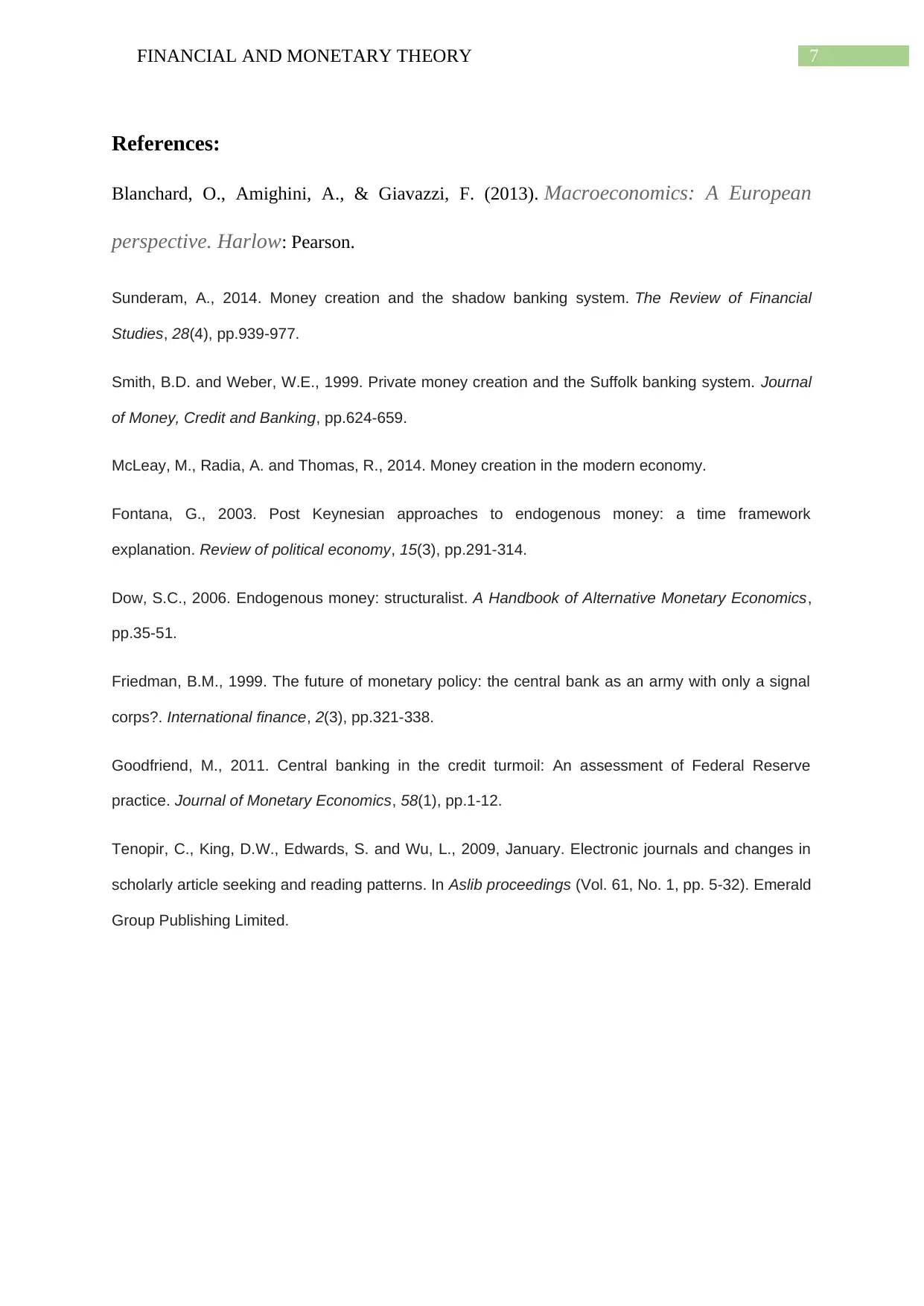
7FINANCIAL AND MONETARY THEORY
References:
Blanchard, O., Amighini, A., & Giavazzi, F. (2013). Macroeconomics: A European
perspective. Harlow: Pearson.
Sunderam, A., 2014. Money creation and the shadow banking system. The Review of Financial
Studies, 28(4), pp.939-977.
Smith, B.D. and Weber, W.E., 1999. Private money creation and the Suffolk banking system. Journal
of Money, Credit and Banking, pp.624-659.
McLeay, M., Radia, A. and Thomas, R., 2014. Money creation in the modern economy.
Fontana, G., 2003. Post Keynesian approaches to endogenous money: a time framework
explanation. Review of political economy, 15(3), pp.291-314.
Dow, S.C., 2006. Endogenous money: structuralist. A Handbook of Alternative Monetary Economics,
pp.35-51.
Friedman, B.M., 1999. The future of monetary policy: the central bank as an army with only a signal
corps?. International finance, 2(3), pp.321-338.
Goodfriend, M., 2011. Central banking in the credit turmoil: An assessment of Federal Reserve
practice. Journal of Monetary Economics, 58(1), pp.1-12.
Tenopir, C., King, D.W., Edwards, S. and Wu, L., 2009, January. Electronic journals and changes in
scholarly article seeking and reading patterns. In Aslib proceedings (Vol. 61, No. 1, pp. 5-32). Emerald
Group Publishing Limited.
References:
Blanchard, O., Amighini, A., & Giavazzi, F. (2013). Macroeconomics: A European
perspective. Harlow: Pearson.
Sunderam, A., 2014. Money creation and the shadow banking system. The Review of Financial
Studies, 28(4), pp.939-977.
Smith, B.D. and Weber, W.E., 1999. Private money creation and the Suffolk banking system. Journal
of Money, Credit and Banking, pp.624-659.
McLeay, M., Radia, A. and Thomas, R., 2014. Money creation in the modern economy.
Fontana, G., 2003. Post Keynesian approaches to endogenous money: a time framework
explanation. Review of political economy, 15(3), pp.291-314.
Dow, S.C., 2006. Endogenous money: structuralist. A Handbook of Alternative Monetary Economics,
pp.35-51.
Friedman, B.M., 1999. The future of monetary policy: the central bank as an army with only a signal
corps?. International finance, 2(3), pp.321-338.
Goodfriend, M., 2011. Central banking in the credit turmoil: An assessment of Federal Reserve
practice. Journal of Monetary Economics, 58(1), pp.1-12.
Tenopir, C., King, D.W., Edwards, S. and Wu, L., 2009, January. Electronic journals and changes in
scholarly article seeking and reading patterns. In Aslib proceedings (Vol. 61, No. 1, pp. 5-32). Emerald
Group Publishing Limited.
1 out of 8
Related Documents
Your All-in-One AI-Powered Toolkit for Academic Success.
+13062052269
info@desklib.com
Available 24*7 on WhatsApp / Email
![[object Object]](/_next/static/media/star-bottom.7253800d.svg)
Unlock your academic potential
Copyright © 2020–2025 A2Z Services. All Rights Reserved. Developed and managed by ZUCOL.





